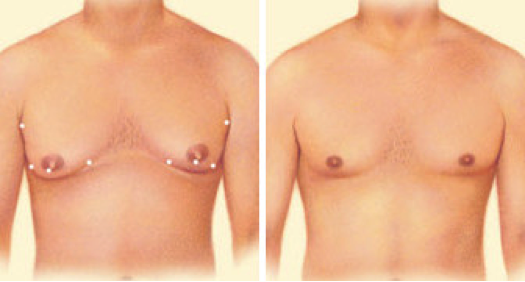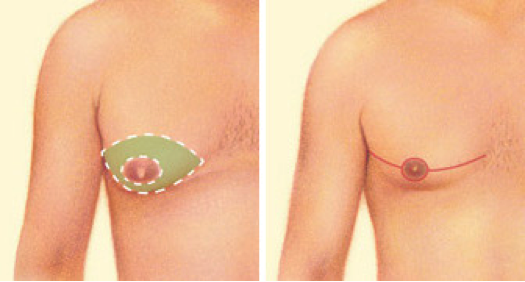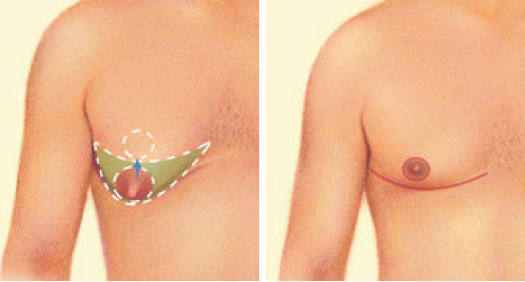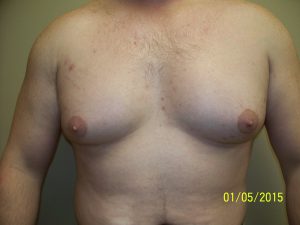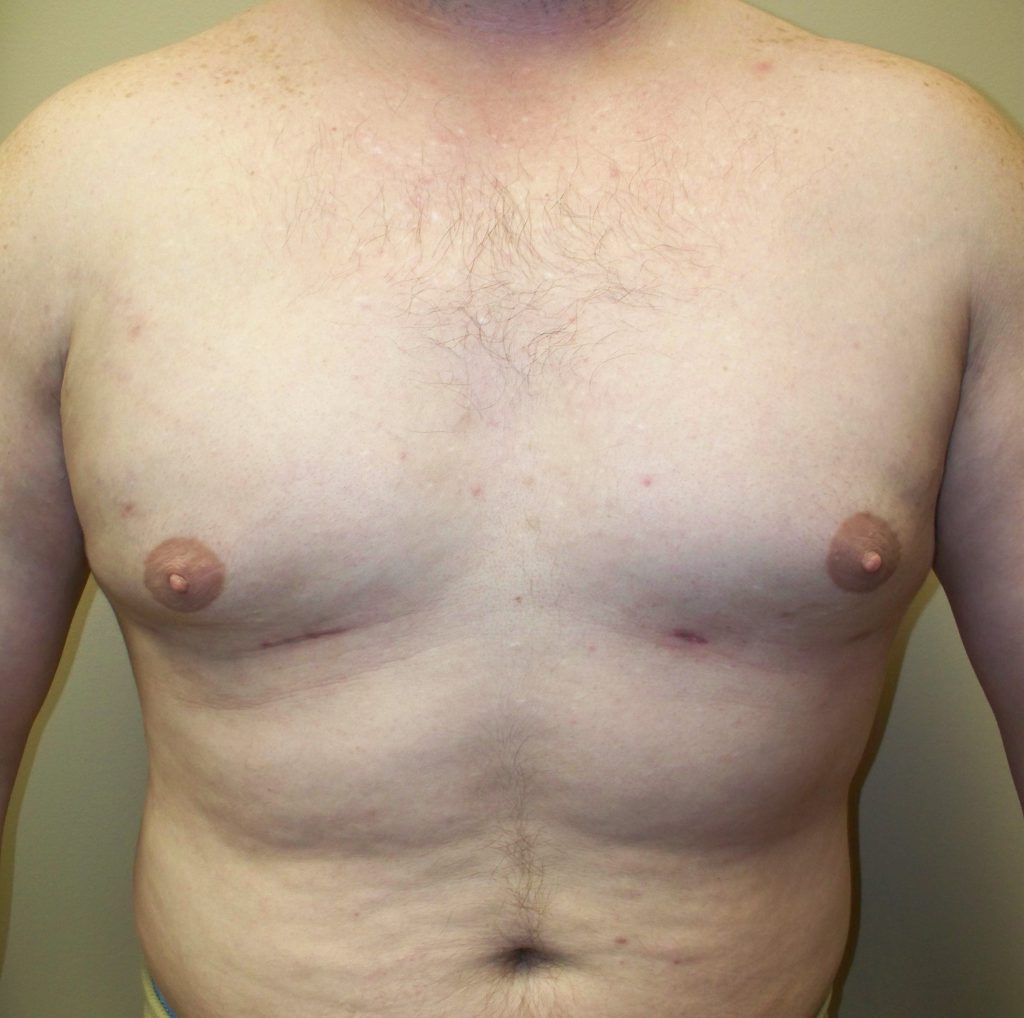Male Body Contouring Surgery – Oklahoma City
What is gynecomastia?
Gynecomastia is a over-developed or enlarged breasts condition in men that can happen at any age. The condition can be from heredity, obesity, hormonal changes, or the use of certain types of drugs.
Gynecomastia can make you have emotional discomfort and lower your self-confidence. Some men may have to restrain from during certain physical activities and intimacy just to hide their condition.
Gynecomastia is characterized by:
- Excess localized fat
- Excess glandular tissue development
- Sometimes excess breast skin
- Presence unilaterally (one breast) or bilaterally (both breasts)
Gynecomastia surgery recovery
During your gynecomastia surgery recovery period, gauze or bandages may be applied to your incisions and you may be covered in an elastic bandage or garment that will be used to minimize swelling and support your new chest contour as it heals after surgery.
To drain any excess blood or fluid, they may temporarily place small, thin tubes under the skin.
You will be given direct instructions on how to care for the surgical site and drains, what medications to apply or to take orally for healing, certain concerns to be aware of, and when the best time is to follow up with your plastic surgeon.
Be sure to ask your plastic surgeon specific questions about what you can expect during your individual recovery period.
- Where will I be taken after my surgery is complete?
- What medication will I be given or prescribed after surgery?
- Will I have dressings/bandages after surgery? When will they be removed?
- Are stitches removed? When?
- When can I resume normal activity and exercise?
- When do I return for follow-up care?
It’s very important to follow your plastic surgeon’s instructions and attend follow-up visits as scheduled.
The final results of gynecomastia surgery are permanent in many cases. However, if gynecomastia resulted from the use of certain prescription medications, levitra drug (including steroids), or weight gain you must be fully free from these substances and remain at a stable weight in order to maintain your results.
Please discuss this with your physician before making changes to your prescription medications.
Recovering from gynecomastia surgery at home
If you begin to experience chest pains, unusual heartbeats, or shortness of breath, seek medical help immediately. Should any of these breast reduction complications happen, you might need hospitalization and additional treatment.
Following you physician’s instructions is the key to healing and having a successful surgery.
It is crucial that the surgical incisions are not subjected to excessive force, swelling, or motion during the time of healing. Your doctor will give you exact instructions on how to care for yourself and how to minimize gynecomastia surgery risks.
Gynecomastia surgery risks and safety
The choice to have plastic surgery is completely personal, and you will have to decide if the results will fulfill your goals and if the potential complications and risks of gynecomastia surgery are acceptable.
These risks and others will be fully discussed prior to your consent. It’s important that you discuss all your questions with your plastic surgeon prior to the surgery.
Gynecomastia surgery risks include:
- Reactions to tape, suture materials, glues, topical preparations or injected agents
- Anesthesia risks
- Bleeding (hematoma)
- Blood clots
- Breast asymmetry
- Breast contour and shape irregularities
- Changes in nipple or breast sensation may be temporary or permanent
- Damage to deeper structures – such as nerves, blood vessels, muscles, and lungs – can occur and may be temporary or permanent
- Deep vein thrombosis, cardiac and pulmonary complications
- Fatty tissue found in the breast might die (fat necrosis)
- Fluid accumulation (seroma)
- Infection
- Persistent pain
- Poor wound healing
- Possibility of revisional surgery
- Unfavorable scarring
These risks and others will be fully discussed prior to your consent. It’s important that you address all your questions directly with your plastic surgeon.
Gynecomastia surgery procedure steps
A gynecomastia procedure includes the following steps:
Anesthesia
Medications are administered for your comfort during the surgical procedures. The options include intravenous sedation and general anesthesia. Your doctor will recommend the best option for you.
Liposuction technique
In cases where gynecomastia is primarily the result of excess fatty tissue, liposuction techniques alone may be used. This requires insertion of a cannula, a thin hollow tube, through several small incisions.
The cannula is moved back and forth in a controlled motion to loosen the excess fat, which is then removed from the body by vacuum suction.
There are various liposuction techniques that may be used; the technique most appropriate in your case will be defined prior to your procedure.
Excision technique
Excision techniques are recommended where glandular breast tissue or excess skin must be removed to correct gynecomastia. Excision also is necessary if the areola will be reduced or the nipple will be repositioned to a more natural male contour. Incision patterns vary depending on the specific conditions and surgical preference.
Combination of liposuction & excision techniques
Sometimes gynecomastia is treated with both liposuction and excision.
Additional Information About Gynecomastia:
Men are becoming increasingly aware of the values of cosmetic surgery including liposuction and tummy tuck, particularly after massive weight loss. The same plastic surgery procedures that help women achieve greater self-esteem can also benefit men. Body contouring is a general term for a range of cosmetic procedures that can reshape your body by removing or manipulating your fat, skin, and muscle to create a more fit physique.
Oklahoma City board certified plastic surgeon Jeanette Padgett understands that face, chest, and abdomen contouring must have unique male aspects. In addition to Male Breast Reduction, Dr. Padgett offers a wide range of body contouring surgery techniques for men to help you achieve the body you’ve always wanted.
During your consultation, Dr. Padgett will discuss your concerns with you and explain the details of male body contouring surgery. There are a number of options to consider, and Dr. Padgett will help you find the best combination to help you achieve your goals.
Gynecomastia, or enlarged male breasts, can be treated with liposuction or a breast reduction procedure. Both procedures maybe needed to give you a flatter, more contoured chest, increase your self-confidence, and reaffirm your masculinity. Enlarged male breasts are very common. Gynecomastia affects 40 to 60 percent of the male population.
Some medications can cause gynecomastia. However, you may be one of the many men Oklahoma City board certified plastic surgeon Jeanette Padgett treats who suffer from enlarged male breasts, gynecomastia, with an unknown cause. Dr. Padgett will discuss your concerns with you and explain the details of male breast liposuction or reduction cosmetic surgery.
Before
After
